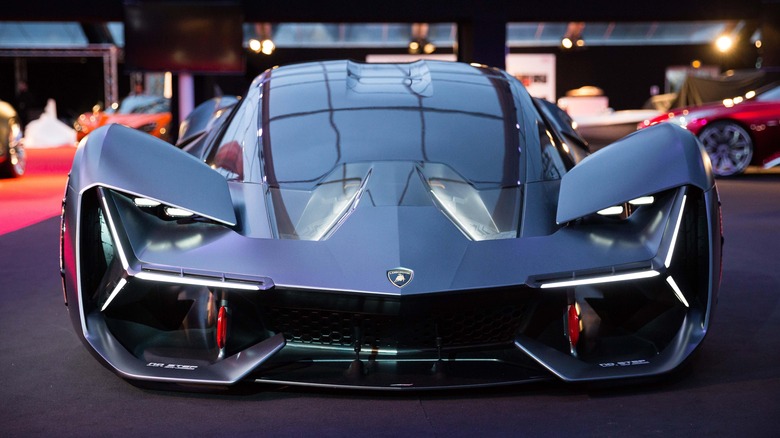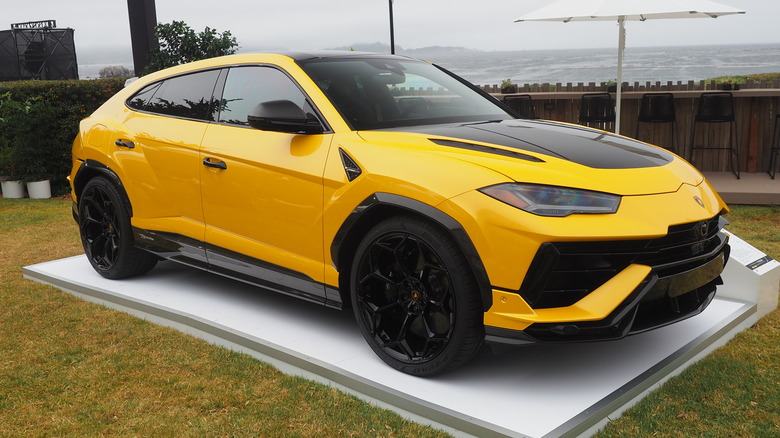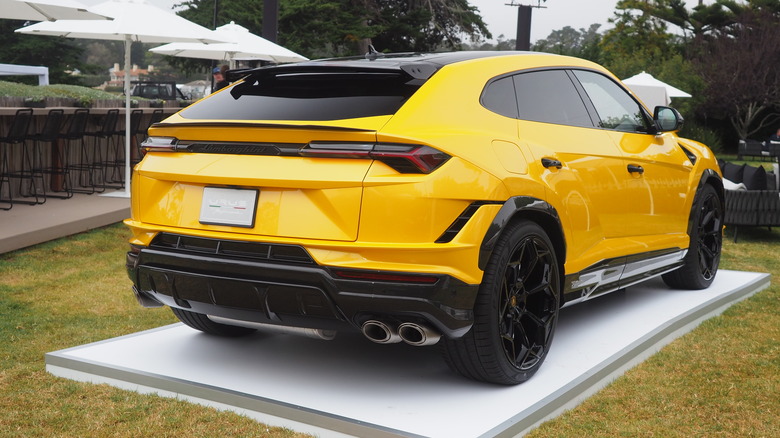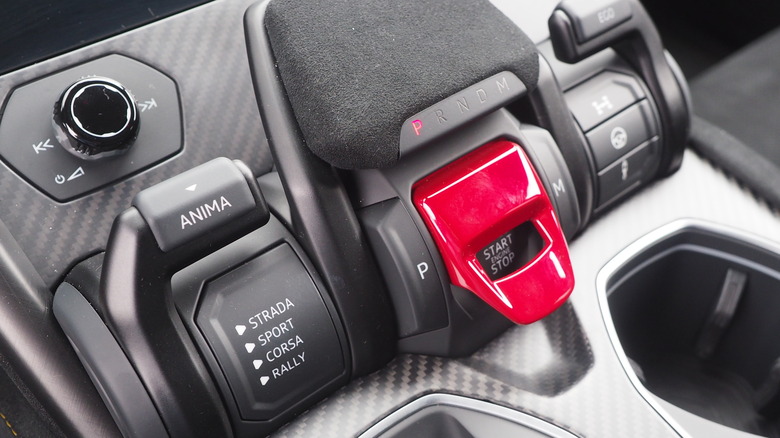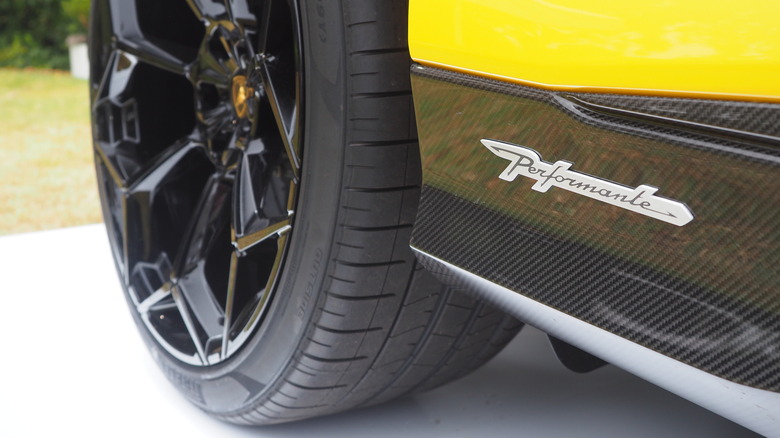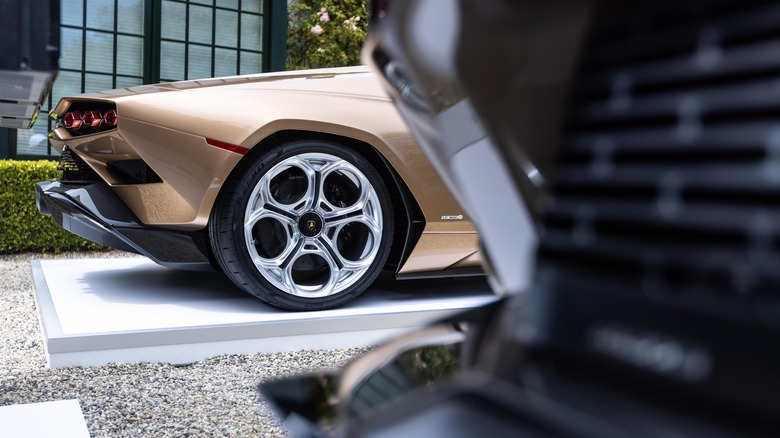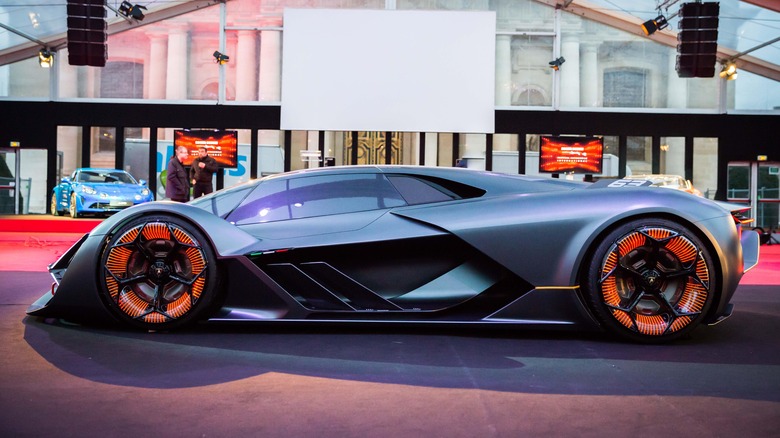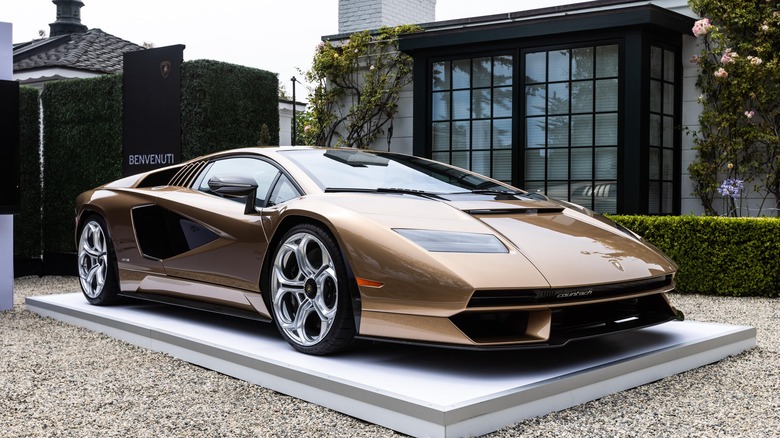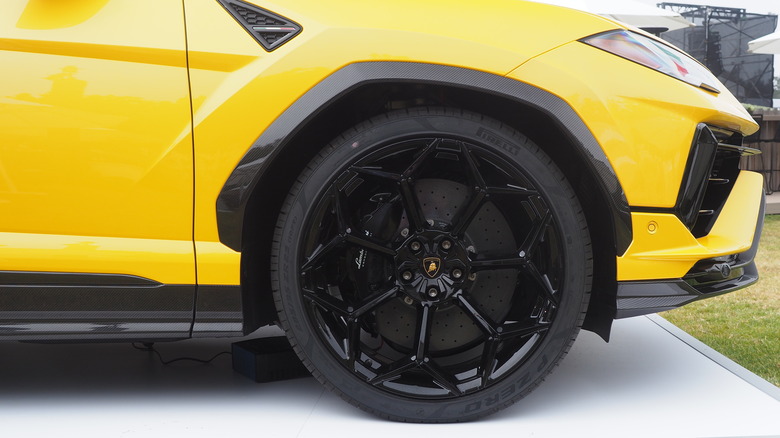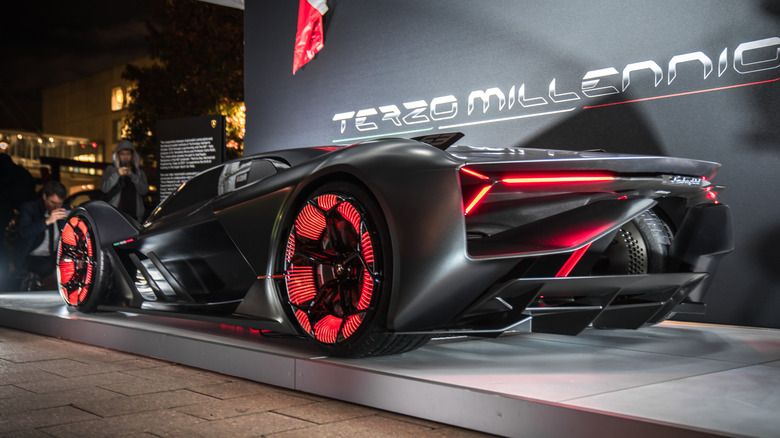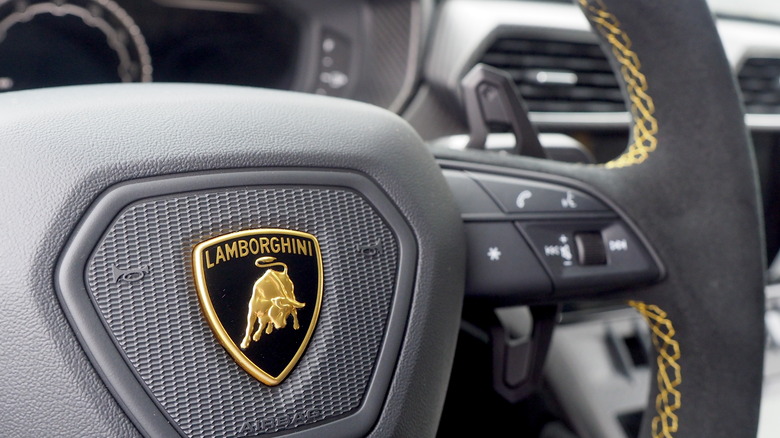Lamborghini's Biggest Electric Supercar Challenge Isn't What You Think — Exclusive Interview
There's more to a supercar than speed, and never has that been more relevant an observation as the heavyweights in performance begin their evolution into electrification. For Lamborghini — once the epitome of temperamental Italian muscle, and now arguably cornering the market on pace with personality — that transition is a wake-up call to a new world where power is free, minivans can have launch control, and the definition of fun is ready for a rethink.
While the automaker's big Monterey Car Week 2022 debut may have been the Urus Performante, an even more potent — and thoroughly gas-powered — version of its best-selling SUV, Lamborghini isn't letting its combustion successes blind it to the reality of what comes next. As Rouven Mohr, Chief Technical Officer, explained to SlashGear in an exclusive interview at the California auto show, the key to success in electrification may well be ignoring the numbers altogether.
This interview has been edited for length and clarity
SUV bragging rights
Certainly, you could look at the Urus Performante and wonder whether — beyond bragging rights — Lamborghini really needed to build its newest SUV. The standard Urus is already the automaker's best-selling car and is hardly slow in its own right. 0-62 mph in 3.6 seconds, and a 189 mph top speed is more than enough to warrant the "supercar SUV" billing.
The Urus Performante, though, had potent rivals to embarrass, and so Lamborghini set to work making the sweeping changes required to drop weight and add power. On the one hand, the result speaks for itself. A 0-60 time trimmed to 3.3 seconds, and a new world record at the notorious Pikes Peak summit climb.
Speed, though, wasn't the real goal, Mohr reveals. "The majority is driving fun: the car has to be performance-oriented, so objectively fast. Not only in a straight line," he says. "And daily usable, because for sure, one of the key ingredients of this car is not the power: there are two key ingredients. The first one that we decided was to change from the air suspension to the steel one. This is the only car in the segment that has steel suspension, and this is — for this segment — a radical step."
The Lamborghini mission
It's a self-imposed challenge that, within reason, sees Lamborghini step off the treadmill of maximum speed above all else. While the typical customer may have deep pockets and a taste for acceleration, Mohr and his team is also realistic in acknowledging that only a fraction of that audience has legit racing skill. "Our task is to give them a car that they can enjoy, and they have fun with the car," he explains. "This was the mission."
Ironically, then, though the Urus Performante is certainly speedier than the regular Urus (which will stay on sale alongside it), Mohr isn't convinced that most owners will actually be able to tell the difference. "I can guarantee to you, you will not feel — if you go zero to 200 — you will not feel the time improvement," the CTO says. "There is one, but you will not. You can read it in a newspaper and say, "okay, I'm so proud, I'm so proud," but in reality you cannot feel it."
Instead, the emphasis is on more usable performance and part of an overarching ethos for engaging sports cars that has relevance beyond just high-displacement super SUVs. "You will feel directly that the steering behavior feels completely different," Mohr explains. "And also, when you are fast on the mountain roads, you feel even in the absolute limit of the of the public road, you feel that the car turns better in, the car follows much, much more better your steering request. This gives you trust in the car, and then you can go easier to the limit. This is my philosophy."
Beyond launch control
It's a focus that seems increasingly prescient given how the electric vehicle world is developing. EVs are well past needing to prove they're capable of outrageous performance: Tesla's Model S Plaid can outrun hypercars, and the freshly-announced Lucid Air Sapphire promises to be even faster. Even more attainable models can boast horsepower and acceleration numbers that once would've required keys to a sports car, though.
That, Mohr counters, is the easy route to headlines. Perhaps, even, the lazy one. "The business at the moment, everybody is looking for faster, faster, more power, especially with the electric world, because it's easy to generate this number," he argues. "But I'm deeply convinced this will end up very soon — not soon in the sense of tomorrow — but the people will recognize that if you have, what, five megawatts, two megawatts, nevertheless, it's not more fun."
For sure, the electric Lamborghini won't be slow. What it will have, Mohr insists, is tap electrification in a way that actually reflects what its audience wants. In short, being willing to give up on metrics that, though they may have helped define decades of supercar development, arguably just aren't relevant anymore with EVs.
"I don't know any of my friends — and my friends are also a little bit car crazy — that take a car on Sunday morning out of the garage, on their own, make a launch control start and are happy: "oh, I'm 2.1 seconds." It doesn't matter," Mohr laughs. "I mean, for sure you need a certain level of performance to be credible. The car cannot be slow. But to have always this number crunching, it's the wrong way."
Fake engine sounds aren't the answer
Mohr certainly isn't averse to a gas-powered car. In addition to the Urus, the engineer oversaw development of the Aventador and the Huracán, each worthy of modern-day-icon status. Before that, at Audi, he was Head of Project Management Whole Vehicle for the equally-iconic TT, among other models.
"I love combustion engines, without doubt," he insists. "I'm also deeply convinced that we will find very cool electrification. Because at the moment everybody's scared because missing sound, missing character. Every car is the same, yes, at the moment I would also underline this. For daily use, a car, it's okay, but the last 20% of emotions are not there, at the moment. But we will find it."
What that won't mean — regardless of what the rest of the EV world might be playing with — is taking shortcuts to borrow presence. "I'm deeply convinced it cannot be fake artificial sound," Mohr says, "and it cannot be only longitudinal. Because this will be the commodity because, in the electric world, if we have the right battery with amount of voltage and ampere that you need anyhow for the fast charging, you get the power for free. So the peak power, the value of the peak power, loses completely the meaning."
EVs that do what gas guzzlers can't
Admittedly, Lamborghini isn't alone in hunting for the inherent advantages of the electric car platform beyond just speed. The Model S Plaid and Air Sapphire, for instance, double up on their rear electric motors for a total of three. Bugatti is busy exploring ways it can reshape aero to flow through its electric hypercars, not just around them. Once you remove the mechanical link between an engine, a transmission, and the wheels, the possibilities of a more distributed powertrain start to look even broader.
How that's taken advantage of, Mohr argues, will be what makes the difference. "You have much more opportunities regarding the control possibilities of the car," the engineer suggests. "I'm not talking about what everybody's mentioned: torque vectoring, blah, blah. One stupid example, if you look today at the traction control, the traction control always works coming from down. So less slip to maximum slip, limiting the maximum slip, because the inertia of the drivetrain does not allow you to really do something different."
Electric cars, and more specifically the precise control that's afforded over the behavior of electric motors, could upend what have so far been the de-facto way that ubiquitous systems like traction control operate. "So theoretically — I'm not saying that it makes sense — but theoretically you can build a car where you have permanent wheelspin," Mohr teases. "You come from the top, so you're on the slip limit, but a little bit on top. And this you can do with one, single wheel, so you can do really crazy things. That, I'm deeply convinced, can bring the directedness of driving fun to another level; to do things with cars that are not possible with a combustion car."
Current electric cars are struggling to stand out
Do we really need EVs that flirt with spinning their wheels by default, not by mistake? As Mohr says, maybe that doesn't entirely make sense. Still, the underlying strategy of questioning why things were done the way they were done before, and if there's a better way when you're already upending the powertrain, feels different to most of the boasts we've heard from automakers with combustion-challenging electric models to sell.
"I think that this will be, in the future, the differentiation topic between the standard high-power electric car and a sports car," Mohr suggests. "We have to check what is really the new driving fun. This we have to reinvent. But it cannot be the number of 0 to 60, to be honest; these days, I don't even really read the numbers."
Along the way, there's the possibility that not everyone will appreciate that approach. That's as much the case for Lamborghini's current, gas-powered line-up as it will be for its EVs. "Our cars are very characterful," Mohr points out. "You jump in Lamborghini, independent from the model, you feel that the car has a character. Some people like, some people don't like, but it's a clear character. And to bring this in the electric world, this is also my mission. Because if you jump today from one electric car to the other one, with closed eyes, it's hard to see any difference."
Avoiding being an anachronism
It's fair to say that, unlike the mainstream automakers, performance car companies have taken a more cautious approach to electrification. Indeed you could argue that most of the bigger names are still clinging to their internal combustion legacies, even as they look ahead. Lamborghini's own Countach LPI 800-4 is one especially conspicuous nod to the old-school approach to supercars, though it's retro styling actually wraps around a hybrid drivetrain (albeit one with just 34 horsepower from the electric motor).
While that may keep the old guard happy, it's a temporary measure at best. Lamborghini, too, is aware that the writing is on the wall: not only for fossil fuels, but as its younger clientele begins to play a larger role in sales.
"Even if you're a guy that loves combustion engines, [with] the limits of your power potential, you have no chance," Mohr says, bluntly. "Even if the global regulations would allow you to continue, if you want to be in this high-performance segment, the potential of the electrified car is so much higher, that you are a kind of anachronism. I'm pretty sure there will be still some people that will appreciate this, but the majority — the young generation — for them, it's not fast, not exciting enough."
The 1.5 megawatt minivan
The key will be delivering power with personality. "The power will be for free, and will be a commodity," Mohr suggests. "I mean, there will be minivans, SUVs, with 1.5 megawatts. This will not make the differentiation."
When every electric vehicle has more power than drivers know what to do with, the metrics of what makes a car worthy of being a "supercar" or even a "hypercar" will have to evolve. "People were trained for decades, that the power number makes you cooler," Mohr says. "But in the past, if we speak about the combustion world, it's also hard to generate this power. Look at the marvelous W16, how much technical effort is needed to generate — at this time, when the Veyron came out — 1,001 horsepower? Today, with an electric car, 1,001 horsepower, you don't really read the number anymore. You, say okay, it's a minivan, or what?"
The replacement figure for that, arguably, has become electric range. Just how far your EV will take you on a full charge is clearly a source of significant anxiety, particularly among new or potentially-new owners. For those who buy supercars, meanwhile, long-distance driving is only part of that concern.
Range anxiety on the track
The other part is range at the track. While the typical race course may amount to a handful of miles at most, the demands of sustained high-performance driving can be exponentially greater than of everyday trips. As Mohr puts it, "it's hard if you are only able to do one lap."
"Therefore, you need a certain level and — especially in this case — to increase the battery capacity is not the right way," the engineer points out. "Because weight is, for a sports car, one of the main targets."
Don't confuse that, though, with needing 300 miles of lap range, however. Gas-powered sports cars may not have the constraints of batteries to consider, but they still have to hit the pits every so often. "If you drive a sports car very hard, depending on the track, more than five laps, with your tires, with your fuel, you have to do some things," Mohr lists off. "You have do a cool-down lap, or you have to refuel."
The sweet spot, he predicts, is five or six laps, depending on the length of the track itself. If you could then add enough range to your performance EV in 5-10 minutes — even if you weren't using slick-but-impractical battery bodywork as in the Terzo Millennio concept – it would leave the car pretty much on a par with the considerations of an internal combustion engined counterpart would need to make on track days.
The key to 'even more fun'
Just how many Lamborghini owners — or, for that matter, owners of any supercar — actually take their cars to the track on a regular basis is unclear. Still, just like with top speed and acceleration, knowing that you could is arguably as important as the actual ability. To convince enthusiasts to give electrification a chance, Mohr says, Lamborghini and its counterparts will need to do more than just emphasize metrics like 0-60 times.
"From the engineering perspective, the electric car has — for driving fun — some really significant advantages. But at the moment, nobody's really focusing [on that]," he suggests. "For sure, to start with launch control, and the quarter mile and everything is fine. But I don't do the quarter mile when I go to the supermarket, I want to have a car with driving fun, right?"
Get it right, though, and people could well decide that not only are electric cars a good alternative to gas guzzlers, but "even more fun," Mohr teases. Exactly when Lamborghini might actually choose to demonstrate that, the new CTO won't be drawn on — "I will not say some months, but some years, I don't know when," he defers — but with rivals like McLaren and Ferrari already launching well-received hybrid supercars such as the Artura, the countdown to the Italian bull's electric retort is on.
